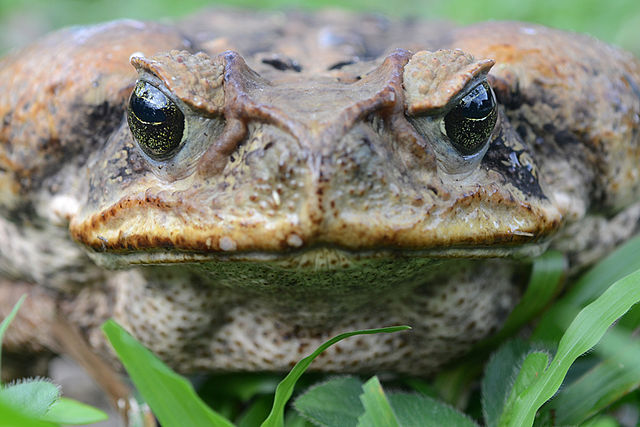Here's lookin' at ya
By Judy Evans
@JudyEv (368754)
Rockingham, Australia
July 20, 2024 12:11am CST
I’ve written before about cane toads which are spreading across northern Australia after being introduced in 1935 to prey on beetles that were infesting sugar-cane crops. Since their introduction into Queensland, they have migrated over 2,000 kilometres westward.
The toads will soon make their way down the Western Australian coast. Because of a poisonous sac, anything that eats them dies, and it is believed that shortly another nine native animals will join the threatened species list through being decimated by eating toads. The toads also wipe out other frog species.
The Western Australian government has now allocated funds to create a ‘waterless barrier’ between the Indian Ocean and the Great Sandy Desert. A 40 by 400 kilometre strip will be made waterless by making cattle watering points unavailable to toads. Hopefully this will halt the westward movement. Traditional land-owners, pastoralists and professionals are combining to create the barrier.
Cane toads breed year-round with females laying between 8,000 and 30,000 eggs at a time. Let's hope this barrier gets implemented - and quickly.
Photo from Wikimedia Commons: Taken by Geoff Gallice from Gainesville, FL, USA
11 people like this
10 responses
@Beestring (15377)
• Hong Kong
20 Jul 24
Yes, hope the barrier gets implemented soon.
2 people like this
@GardenGerty (167147)
• United States
21 Jul 24
Maybe find a way to sterilize them as well. It sounds overwhelming.
1 person likes this
@JudyEv (368754)
• Rockingham, Australia
21 Jul 24
It has been pretty overwhelming for a long time. Any solutions they come up with take ages before any change is noticeable.
@allknowing (153815)
• India
21 Jul 24
Atleast there is no intention to eradicate them. Keeping them away is a good decision.
1 person likes this

@allknowing (153815)
• India
21 Jul 24
@JudyEv They could be consigned somewhere from where they will never return but not kill them.

@RebeccasFarm (91165)
• United States
21 Jul 24
I remember lots of toads when I was a kid in the Ozarks.
1 person likes this
@arunima25 (92830)
• Bangalore, India
20 Jul 24
With that amount of eggs laid every year, they must be growing at a very high rate. And they are endangering so many native species. This is a threat to the ecological balance. This barrier has to be implemented soon. And let's hope that it brings the desired control.
1 person likes this
@JudyEv (368754)
• Rockingham, Australia
25 Jul 24
@arunima25 I'd be really interested to hear about it. It's easy to forget that Australia isn't the only planet affected. I know England has trouble with a small deer and the red squirrel.
1 person likes this
@arunima25 (92830)
• Bangalore, India
24 Jul 24
@JudyEv We are facing a huge problem with one turtle here, it's growing at the expense of all other species. I would try to get the details and make a post soon
1 person likes this

@JudyEv (368754)
• Rockingham, Australia
20 Jul 24
It's turn out nearly as bad as the introduction of the rabbit. I'm not sure if the beetles are still a problem. I haven't heard that they are.
@LindaOHio (210169)
• United States
20 Jul 24
Any of these introduced species seem to always cause a problem. I hope they can halt the spread of these toads. Have a good weekend.
1 person likes this















